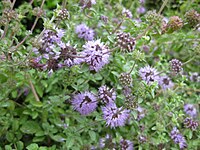
Photo from wikipedia
Multiple biological functions of Mentha pulegium extract were evaluated in the current work. Phytochemical components of the M. pulegium extract were detected by Gas Chromatography-Mass Spectrometry (GC-MS) and High-performance liquid… Click to show full abstract
Multiple biological functions of Mentha pulegium extract were evaluated in the current work. Phytochemical components of the M. pulegium extract were detected by Gas Chromatography-Mass Spectrometry (GC-MS) and High-performance liquid chromatography (HPLC). Moreover, M. pulegium extract was estimated for antioxidant potential by 2,2-Diphenyl-1-picryl-hydrazyl-hydrate (DPPH) free radical scavenging, antimicrobial activity by well diffusion, and anticoagulant activity via prothrombin time (PT) and activated partial thromboplastin time (APTT). GC-MS analysis detected compounds including cholesterol margarate, stigmast-5-en-3-ol, 19-nor-4-androstenediol, androstan-17-one, pulegone-1,2-epoxide, isochiapin B, dotriacontane, hexadecanoic acid and neophytadiene. Chrysoeriol (15.36 µg/mL) was followed by kaempferol (11.14 µg/mL) and 7-OH flavone (10.14 µg/mL), catechin (4.11 µg/mL), hisperdin (3.05 µg/mL), and luteolin (2.36 µg/mL) were detected by HPLC as flavonoids, in addition to ferulic (13.19 µg/mL), cinnamic (12.69 µg/mL), caffeic (11.45 µg/mL), pyrogallol (9.36 µg/mL), p-coumaric (5.06 µg/mL) and salicylic (4.17 µg/mL) as phenolics. Antioxidant activity was detected with IC50 18 µg/mL, hemolysis inhibition was recorded as 79.8% at 1000 μg/mL, and PT and APTT were at 21.5 s and 49.5 s, respectively, at 50 μg/mL of M. pulegium extract. The acute toxicity of M. pulegium extract was recorded against PC3 (IC50 97.99 µg/mL) and MCF7 (IC50 80.21 µg/mL). Antimicrobial activity of M. pulegium extract was documented against Bacillus subtilis, Escherichia coli, Pseudomonas aureus, Candida albicans, Pseudomonas aeruginosa, but not against black fungus Mucor circinelloides. Molecular docking was applied using MOE (Molecular Operating Environment) to explain the biological activity of neophytadiene, luteolin, chrysoeriol and kaempferol. These compounds could be suitable for the development of novel pharmacological agents for treatment of cancer and bacterial infections.
Journal Title: Molecules
Year Published: 2022
Link to full text (if available)
Share on Social Media: Sign Up to like & get
recommendations!